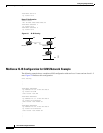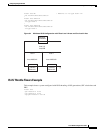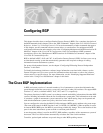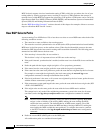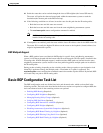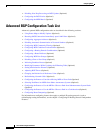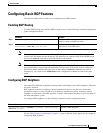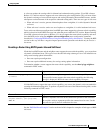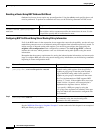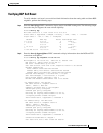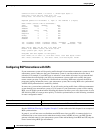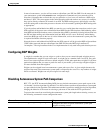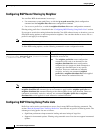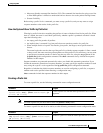
Configuring BGP
Configuring Basic BGP Features
IPC-298
Cisco IOS IP Configuration Guide
Managing Routing Policy Changes
Routing policies for a peer include all the configurations such as route-map, distribute-list, prefix-list,
and filter-list that may impact inbound or outbound routing table updates. Whenever there is a change in
the routing policy, the BGP session must be soft cleared, or soft reset, for the new policy to take effect.
Performing inbound reset enables the new inbound policy to take effect. Performing outbound reset
causes the new local outbound policy take effect without resetting the BGP session. As a new set of
updates is sent during outbound policy reset, a new inbound policy of the neighbor can also take effect.
There are two types of reset, hard reset and soft reset. Table 8 lists their advantages and disadvantages.
Once you have defined two routers to be BGP neighbors, they will form a BGP connection and exchange
routing information. If you subsequently change a BGP filter, weight, distance, version, or timer, or
make a similar configuration change, you must reset BGP connections for the configuration change to
take effect.
Table 8 Advantages and Disadvantages of Hard and Soft Resets
Type of Reset Advantages Disadvantages
Hard reset No memory overhead. The prefixes in the BGP, IP, and
Forwarding Information Base (FIB)
tables provided by the neighbor are
lost. Not recommended.
Outbound soft reset No configuration, no storing of routing
table updates.
The procedure for an outbound reset is
described in the section “Configuring
BGP Soft Reset Using Stored Routing
Policy Information.”
Does not reset inbound routing table
updates.
Dynamic inbound
soft reset
Does not clear the BGP session and
cache.
Does not require storing of routing
table updates, and has no memory
overhead.
Both BGP routers must support the
route refresh capability (in Cisco IOS
Release 12.1 and later releases).
Configured inbound
soft reset (uses the
neighbor
soft-reconfiguration
router configuration
command)
Can be used when both BGP routers do
not support the automatic route refresh
capability.
Requires preconfiguration.
Stores all received (inbound) routing
policy updates without modification;
is memory-intensive.
Recommended only when absolutely
necessary, such as when both BGP
routers do not support the automatic
route refresh capability.



